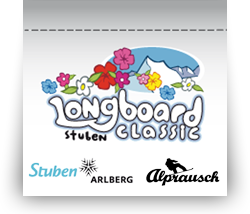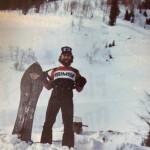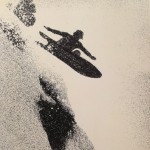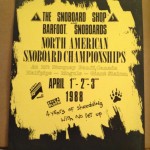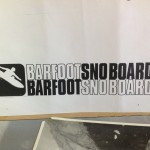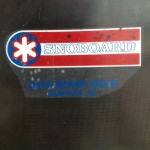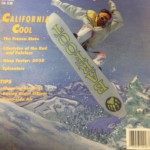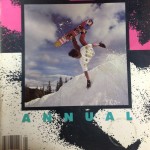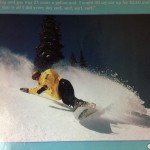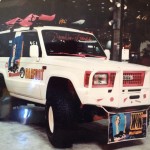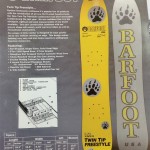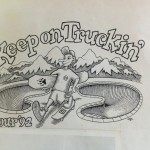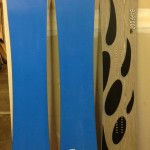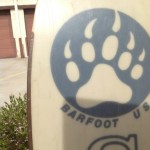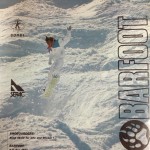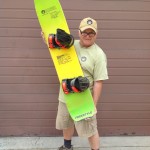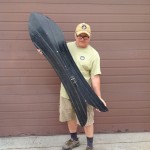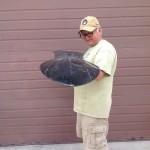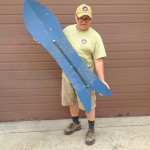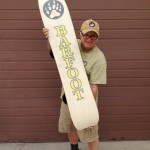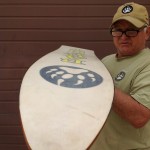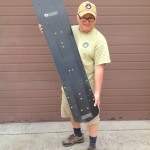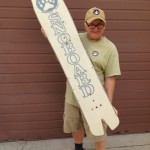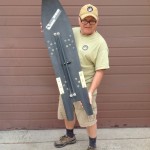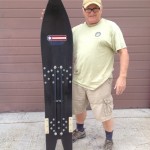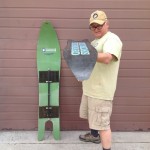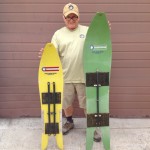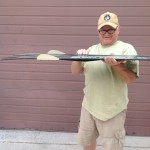Chuck Barfoot | Barfoot SNOboards
written by JP Lagos, 20th Ann. Heckler mag (www.heckler.com)

In 1970, Chuck Barfoot decided to move out West in search of a place to surf year round. Leaving his home in Beach Haven, New Jersey, ending up in the foothills of Santa Barbara. Chuck reunited with Tom Sims who he first met in the 60's at his local surf spot. The pair, along with their friend Raisin, moved into a friends’ mothers’ commune-style home in Santa Barbara. The following year Chuck and Tom moved into a house nicknamed 'Mazatlan'. Mazatlan was a one room adobe brick house with an outdoor kitchen and outhouse (full hippy pad). Chuck lived in the loft, Tom had a bed in the room on the other side. Surfing was Tom and Chuck's passion and lifestyle. Prior to the start of Sims Skateboards in 1972, Chuck and Tom would create 4'-5' long skateboards from old water skis purchased from the local thrift store. Chuck and Tom's goal was to create skateboards that simulated surfing on pavement.
Tom eventually moved to Los Angeles, but Chuck stayed in Santa Barbara, working as a carpenter and artist, but mainly stayed put because of his love for surfing and his life in paradise. A few years later, Tom returned to Santa Barbara and setup Sims Skateboards in a building on Milpas Street. Chuck went back to work with Tom developing landmark skates such as the Brad Bowman "Superman", the Mike Folmer, Bert Lamar, Dave Andrecht and Greg Ayres "Sims Stinger Pro Series".
Before snowboarding was even a sport, Tom Sims had the dream to surf on snow back in his junior high days. Tom came to Chuck while working out a deal to license the Skiboard from Bob Weber in 1977. "The problem with those boards was that they had black griptape for traction which caked on snow and skyhooks that were set up goofy or regular foot only. I hadn’t even snowboarded yet when Tom asked me to help him solve those problems. The first thing we did was switch to a clear, plastic grip tape that we sprayed with silicone, which helped the snow not cake up as much. Next, we put a rubber strap down the middle of the board so you could put your feet under it and ride goofy or regular. This allowed us to share boards since there were so few snowboards at that time. Now the board would stick to your feet so you could jump cliffs and carve in soft snow”, says Chuck.
“Tom asked me to build a board that he had originally buiIt in Junior High, so I made a prototype foam board with a fiberglass stringer down the middle. It had a fiberglass bottom, was about 4 feet long, with a rounded nose and a little swallowtail. The reason I put the stringer down the middle was to stiffen the board and bolt the rubber strap. This was Tom’s design. Tom had two Winterstick Snowboards in the Sims office, which were foam core, ptex bottoms, and fiberglass tops. One was a blue round-tail, the other a yellow swallowtail. The Wintersticks, created by Dimitrije Milovich, were the best boards out at this time. Way before Burton, Tom, or myself made boards he had a true surf style board with no rope on the nose that he was building in ‘72 or ‘73. Tom would never say this, but everyone at Sims saw the Wintersticks every day! They had sidecut and a nylon strap down the center. The problem with the nylon strap was that when you flexed the board in a turn it would get loose. When you used the rubber strap, it flexed when you rode it and stayed tight when turning. About halfway through building Tom's prototype, I told Tom I wanted to build something that would be more functional. He said ‘Go for it’. That's when I designed and built my first board.”
The two worked together until 1980, when Chuck Barfoot decided to venture out on his own and start his own ‘Snoboard’ company, Barfoot Snoboards. Chuck made about 15-20 one of a kind boards. The very first time he went snoboarding, Christmas Day 1978, Chuck and Bob Weber went out to Utah and rode in about a foot of powder. “From that point on, I was hooked! Chuck went back to the drawing board and made a board that was lighter and thinner. He also changed the shape to be more like a Winterstick on his third prototype (1979). “It had a spoon nose. That board just ripped shit!” That board is currently on display at the Colorado Ski and Snowboard Museum in Vail, Colorado.
From that board, Chuck went on to design another board, and another board and so on. Every time he went out and rode a board he had built, he would go back and experiment with something different. “I was working with rockers, channels in the bottoms, even fins! Of course, we didn’t need those fins, but we didn’t know that. We just modeled the snoboards after our surfboards.”
Chuck designed boards until about 1984 before releasing the first true conventional bottom
twin-tip. About a year earlier, Chuck was out in Lake Tahoe for the World Championships when he first saw a double-ended snowboard. It was called the Prop Snowboard, created by Matt Donovan. “The board looked like an airplane propeller, and was a double-ended board. There were no other double-ended boards at that time. Matt came up to me and said ‘Mr. Barfoot sir...’ I interrupted him and said, ‘No, no, no. It’s Chuck’ and he starts telling me all about his board. He walks up the hill, rides down, does a carve, flips it around to fakie, flips it back around to regular, back to fakie, then back to regular. Up until then, nobody had ever done that! I said, ‘Holy shit!’ It was so off the wall!”
Chuck’s company is credited with being the first to create a conventional bottomed twin-tip snowboard, forever changing the way we all ride. Before the twin-tip, every snowboard on the market had a directional shape, snowboarders looked like a bunch of surfers on snow. It wasn’t until after Barfoot manufactured the twin-tip, that skate influenced snowboarding progressed.
About a year later, Ken Achenbach, Neil Daffern, and the Barfoot crew in Canada had developed the very first twin-tip snoboard under the Barfoot name. They sent Chuck the design, and that’s the board Dave Achenbach rode on the very first cover of Transworld Snowboarding Magazine. “That was the first conventional twin-tip snoboard. Those guys designed it and they deserve the credit.” The rest is history. “After that cover, every board company on the planet was making twin-tips or double-ended snowboards. I guess, looking back, we probably should have patented that.”
Chucks’ passion for building boards wasn’t confined to the snow. He’s spent decades creating surfboards and skateboards as well. “I stopped making snoboards about 8 years ago because of some financial crap and business stuff that went sour. That, and the politics in snowboarding just really turned me off. It was not fun anymore." Chuck, however, continued to make surfboards and skateboards. “It’s crazy what started happening with the internet. I had a bunch of people hitting me up out of the blue, asking me to start making snoboards again. Ernie DeLost and Chuck started making boards again, together. It's our life's passion, it’s truly what we love doing!”
“This time, instead of having any problems with partners, Ernie and I are doing everything in-house. Doing it our way. We came to the realization that we love snoboarding. There are people who love riding our boards. We don’t want to be some massive company. We just want to build top of the line snoboards that are both awesome looking, and are built to ride. We’ll have our group of people who ride our boards, and we’ll keep making them for the rest of our lives. When you ride Barfoot boards, we want you to feel like part of the family. I talk to people who want our boards personally to make sure they get what they need. That’s the future of Barfoot Snoboards.”
Chuck and Ernie will be re-launching Barfoot this year at the SIA Snowsports and ISPO Tradeshows, showcasing their all-mountain Barfoot Snoboards.
Gallery
Credits & Links
- written by JP Lagos, 20th Ann. Heckler mag (www.heckler.com)
- www.barfoot.com
- TRANSWORLD SNOWBOARDING- Fathers of Snowboarding: Chuck Barfoot
